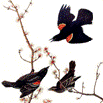Center, Internet, Wildlife Damage Management

Bird Control Seminars Proceedings
Document Type
Article
Date of this Version
November 1979
Abstract
The use of surfactants to reduce winter roosting blackbirds (Icteridae) and starlings (Sturnus vulgaris) in the southeastern United States attracted considerable attention several years ago. At that time concern was expressed that more research was required to ensure that the economic losses and health hazards attributed to the birds were real and that population reduction at winter roosts was a viable solution (Jackson 1976; Robertson et al. 1978). Subsequent research has shown that these concerns were justified. In a study of the winter roost at Milan, Tennessee, Dolbeer et al. (1978) found that the only serious agricultural problems were associated with starlings, a minor species in the roost and the one which would be least affected by surfactant spraying (Lustick and Joseph 1977). As well, from analyses of band recoveries for common grackles (Quiscalus quiscula) by Meanley (1976) and for red-winged blackbirds (Agelaius phoeniceus) by Dolbeer (1978), it was found that in any given winter roost there are birds from widely dispersed breeding populations. This led Dolbeer (1978) to conclude that killing blackbirds at a few winter roosts would not solve the problem of late summer agricultural damage in the breeding areas nor prevent the re-establishment in subsequent years of the winter roosts that were reduced. Serious agricultural damage by blackbirds in the St. Lawrence Valley and the rapidly increasing red-winged blackbird population (Erskine 1978; Dolbeer and Stehn 1979) has led to demands by the agricultural community in this area for solutions to the problem. Not surprisingly, lethal control through surfactant spraying has been suggested as one possible alternative. This suggestion has some merit, because the factors that weigh against a widespread winter roost control program in the southeastern U.S. do not apply to the St. Lawrence Valley. Blackbirds returning to southern Quebec in late March and April form roosts prior to dispersing to breed in May. An analysis of band return data indicated that the birds in this region in April were predominantly from the breeding and early fall population (Weatherhead et al. 1980). This allows the possibility that the populations responsible for the crop damage could be reduced prior to the breeding season, thereby substantially reducing their fall population. Our aim in this paper is to examine the feasibility of surfactant spraying as a management technique in the St. Lawrence Valley of Quebec. Factors that must be considered in a feasibility assessment fall into two general areas -- proximate and ultimate. Proximate factors include the number and size of spring roosts that can be sprayed, hazards to non-target species, meteorological constraints, and the logistics of surfactant spraying. Ultimate factors involve the prediction and assessment of the short-and long-term impact of a spray program on breeding and fall populations and the implications of that impact for the reduction of crop losses.

